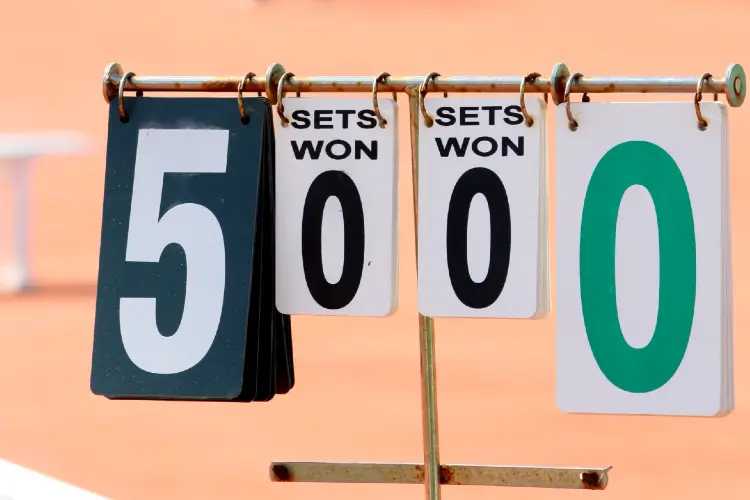Last Updated: September 25, 2023
If you are new to volleyball, understanding its ins and outs can get tricky. Many questions may pop up about how the game works and its scoring system.
In this article, you’ll learn more about volleyball scoring to help you understand the game like a pro. You’ll also learn about the scoring system used in volleyball competitions at different levels.
If these sound like something you’d want to learn about, let’s jump in.
Scoring Points

To begin with, you must understand how a team can score. Here are some of the ways:
 If the ball drops/lands on the opponent’s side of the court, in the area enclosed in the boundary lines
If the ball drops/lands on the opponent’s side of the court, in the area enclosed in the boundary lines If the opponents hit the ball beyond the boundaries
If the opponents hit the ball beyond the boundaries If the opponent serves poorly, resulting in a service error
If the opponent serves poorly, resulting in a service error If the opponents make contact with the ball more than three times consecutively
If the opponents make contact with the ball more than three times consecutively If the opponent crosses the court’s center line or touches the net
If the opponent crosses the court’s center line or touches the net If the opponents come into contact with the ball while it is still on the other side before the attack
If the opponents come into contact with the ball while it is still on the other side before the attack
Now that you understand how points can be scored, there are two ways of scoring in volleyball. These are Rally and Side-out scoring systems.
Rally Scoring
This is the most commonly used scoring system in volleyball matches because it is straightforward. How it works is that the team that wins a rally is awarded the points regardless of whether they served or not.
This implies that both teams, the serving, and receiving, can earn point each time.
Usually, rally scoring is played to a score of 25, following the “best of three” match format. This means that a team must be the first to win two sets to win a match.
The rally point system allows a much more consistent flow of the game without s lot of delays compared to the side-out point system.
Side out Scoring
Side-out scoring used to be the primary scoring system in volleyball matches, but the rally scoring introduced in 1999 has since replaced it.
Sideout is when the receiving team wins a rally and is awarded the chance to serve the ball.
In this scoring system, a team only wins a point if they serve the ball. As such, the receiving team can’t score but can win the rally to win a chance to serve the ball.
The serving team plays offense as they seek to earn a point, while the receiving team plays defense as they seek to win a service.
Matches played using this scoring system can turn out to be very long since the two teams may keep trading serves without winning any points. That is the primary reason why the rally scoring was introduced, to make the average length of volleyball matches more predictable, as well as to make them more spectator and television friendly. (1)
Recommended Read: A Look Through History of Volleyball
The sideout scoring system is played to 15 points, following the “best of three” match format. So, to win a match, a team must win two sets. Additionally, for a team to win a set, it must win 15 points with at least two point lead.
Olympic Volleyball Scoring
In Olympic volleyball, the scoring system used is the rally points method. The matches here are played to 25 points, following a “best of five sets” match format. This means that the players that scores 25 points first wins the set.
If one of the teams wins three of the first four sets, the fifth set won’t need to be played. But if the fifth set needs to be played to break a tie, it will be played to a score of 15. So the first one to reach 15 points first wins the set.
Additionally, to win the set, it must be done with a margin of at least 2 points.
Olympic Beach Volleyball Scoring
Like Olympic indoor volleyball, beach volleyball also uses the rally scoring, where you earn points regardless of whether they served. But here, the games are played to a score of 21 points, following the “best of three” format.
If a team consecutively wins the first two sets, the third set will not be played. But the third set will be played if the two teams win one of the first two sets.
This third set is played to a score of 15 points so that the one that attains the points first wins it.
Like any other volleyball match, players must win the set by a margin of two points.
International Volleyball Scoring
Volleyball matches played professionally in leagues worldwide are governed by the game’s international governing body, the Federation Internationale de Volleyball (FVIB).
The rules used in scoring of the Olympic indoor volleyball matches are applicable to all FVIB-governed leagues. The matches are played to 25 points, with the best of five sets, and in case a fifth set is played, it is played to 15 points.
College Volleyball Scoring
The scoring method used in college volleyball is the rally scoring, more like in Olympic volleyball. The matches are played following the best of five sets with a score of 25 points for each set, except for the fifth set, which is played to a score of 15.
At this level, the two-point winning difference for a set also applies.
High School Volleyball Scoring
Like in the international and collegiate levels of volleyball, the high school level also uses the rally scoring. The sets are played to a score of 25 points, with a winning margin of 2. Additionally, the best of five sets play applies at this level too, and if the fifth set needs to be played, it is played to 15 points.
Nonetheless, the game’s rules may vary depending from one league to another.
How does volleyball serving work?
To serve the ball, a serving member hits the ball from beyond the serving line and over the net toward the receiving team’s side of the court. This creates a rally played until someone wins a point. If the serving team loses a rally, the opponents win a service.
Also Read: Court, Net & Gear – Guide to Volleyball’s Setup
The server should not step over the serving line before they hit the ball. The server should also hit the ball within bounds and above the net. The serving team loses the point if any of the three requirements are not met.
The player who serves is in the right back corner of the court.
Conclusion
Scoring is important in any game. Volleyball si no different, it is the essential factor that determines who wins a match.
There are mainly two scoring systems which are the rally and the side-out.
In the rally scoring system, a team can win a point if the opponents fail to return the ball, hit the ball out of bounds, make a service error, or commit an infarction.
On the other hand, in the old side-out scoring system (used until 1999), a team can only win a point if they serve the ball. The receiving team can only win a chance to serve the ball but not a point. This system often lead to extremely prolonged matches since the teams can keep exchanging services instead of winning points.
The rally scoring system is quite straightforward. The matches are played based on a score of 25 points and the “best of five sets.” If the last set needs to be played, it is played to a score of 15 points, with the winner having a two-point lead.
However, in some organizations, the first one to reach 17 points wins, and the two-point difference is not required.
